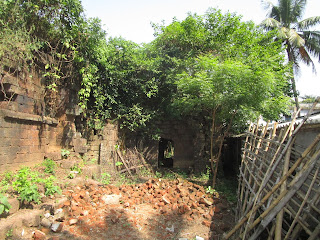If
anybody searches in google map “JINSAR , WEST BENGAL”, a location in west
Medinipur will appear on the screen along with blue marking of
Kanshabati river. With a little zoom-in
will show a label “Ancient Ruin of a Digambar Jain Temple” more towards the
river. Recently two bloggers had shared their findings on this ruin through
their article; one of them a historian and the other an enthusiastic travelogue
writer. Based on one of their reports, another information is also evident in face-book.
Way
back in fifties when the eminent Bengali scholar Binay Ghosh visited Medinipur
to collect materials for his monumental book “Paschimbanger Sanskriti” (The culture
of West Bengal). During this travel he had been to this place and pointed out
that “Jinsar” denotes Jin Sahar (City of Jain).
If
one observes the current maps of Jharkhand and West Bengal one finds distinct
links of age old Jain heritage at different locations of lower eastern part of
Jharkhand and lower western part of West Bengal (Giridih- Dhanbad- Bokaro-
Puruliya- Bankura- West Midinipur). These links are broadly classified in two
groups. The first one, earlier Jain structures still in use as hindu temple
(Begunia in Barakar, West Bengal) or Jain statue becoming symbol of hindu God
(dressed in red loin-cloth) placed inside a new structure attracting regular
attention of devotees (Polkiri in Bokaro, Jharkhand). The second group is the
heritage structure which were submerged during the construction phase of
reservoirs of DVC Project (Telkupi ,Puruliya, West Bengal) in early fifties. A
few, however, became visible since 2005 due to silting .
One
observes that all these Jain Temple clusters were developed beside river
networks of Damador, Barakar and Kanshabati, clearly indicating a primary
navigational river high-way for commerce of an age old civilization. Budhist
and Jain Sreshthis (merchants) were common characters in old scriptures as well
as in modern texts of nineteenth century. The construction material is not
burnt-brick but finely cut stone brought from outside Bengal, suggesting
patrons had rich resources. The period of execution accessed eleventh to
twelfth century.
As
per Jain documentation the aboriginals of this place (Porto- Australoid Tribes)
were not having any friendly attitude towards Thirthankar Mahavir. Was it an
indication of conflict between rude Foragers and cultured Aryans ?
Available
archeological evidences of Tamluk (Tamralipto) region of southern Medinipur
strongly indicate it as a seat of non-Aryan civilization of copper-age
transformed into a busy river harbor and into a Buddhist university-town (?) between fourth and seventh century (documented
travelogue of famed Chinese Monks). In eleventh century it became A part of the
Kingdom of Rajendracholdev and in twelfth century it came under the
administration of Chorgangadev. The Buddhist and Jain doctrines of different
eras were having their simultaneous influence in Medinipur. The eco-political
scenario of this particular landmass of modern West Bengal withstands the
cultural syntheses of south as well as north India. Whatever might be the
historic socio-religious evolution of this area the western part of this
district always displayed the urge for independence and determination to avail
the same (Forager’s gene? / Red Corridor ?). It had survived as the battlefield
between Mughal and Pathan; it remained the soft-target of yearly Maratha
invasion of Bengal during the fag end of Mughal Dynasty; the “Chuar Rebellion”
was the first revolt against administration of British India much before “Sepoy
Mutiny” of 1857 (unfortunately never highlighted beyond scholastic world).
The
ruin of “Jinsar” is remarkable as this age old piece of heritage structure is
going towards oblivion due to extreme negligence from modern India. The
district which withstood wave after wave of military onslaught, religious
vortex and political turmoil failed to preserve its archeological beauty. On
the other hand, extensive touring in this region (eastern part of Jharkhand and
lower western part of West Bengal) gives the impression: “against the huge time
scale the religion of the locality changed from one form to another but the
God’s Idol remains live by the believers. It had remained a solace to the
villagers; it would continue its peaceful influence on the anxious minds in
future. Religion, society and time may change but the Idol remains as an
assimilation of Indian heritage and legacy forever, and continued to be an
emblem for all hopes and good deeds and a symbol of destroyer of all evils”.
The old Jain statue of
ruined Digambar Jain Temple of Jinsar proved the above theory absolutely wrong.
If
you feel anyway curious about this relic please go through the below mentioned
links, as modern Indian it is our duty to preserve our heritage.
Sources :
4. Pashimbanger Sanskriti by Binoy Ghosh
5. Special courtsey Mr. Tarun Tapas Mukherjee & Md. Yeasin Pathan.
Research : Abhijan Basu and Santanu Roy.
Photo courtsey : Santanu Roy.














10 comments:
Thank you so much for these hitherto unknown rare places and informations !
Thank you for drawing my attention to it and for reminding us of this forgotten slice of history.
Wonderful narration supported with excellent pictures. Good Information !!
wonderful
very nice post. Thanks for sharing. To stay update with latest news from all over the world in bengali please visit Keykhabor
Thanks for sharing this...Please visit our art gallery: Art Gallery in Kolkata!
এইসব লেখা বাংলা ভাষায় বই হয়ে আসা উচিত
Thank you.
Post a Comment